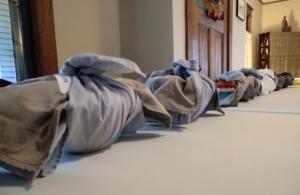
I forgot a few important things when writing the last post, “The Dharma of Taking Food: The Zen Art of Oryoki,” but thankfully, I have been reminded by caring others. So in this post, some more about an important practice opportunity. First, I’ll share a bit more about Wiping Cloth Sensei, and then unveil the Gansho Oryoki Incident Drama Scale (GOIDS), modelled after the better know Saffir–Simpson Hurricane Wind Scale (SSHWS). We also have a solid acronym – “goids!,” just what Dōgen said one should say when a cup of yogurt plops in one’s lap.
After reading the last post, a student wrote, “I have long since given up on being able to unrumple Wiping Cloth Sensei, but somehow it did not occur to me that the point was that you can’t. Very deep teaching for this person who is prone to perfectionism.”
Just so.
Significant too, as the ever subtle and profound Tetsugan pointed out, “The clothe, just as rumpled as it is, fits perfectly into the Buddha bowl (the large bowl). Just like the mess that we are.”
Now in any human activity designed to flow with perfection, there is error. Lots of error. And no matter how good a group gets at the flow of the oryoki meal, there will be incidents that are both humbling (so we get to take a look at that in the context of deep, quiet mind) and funny. There is a rule against laughing during the meal, of course, and that makes these incidents even funnier.
So Tetsugan and I, after years of a true double-blind scientifically super-sound research (a technical term), have discovered the Gansho Oryoki Incident Drama Scale (GOIDS). Yes, “discovered,” because it was already there, hidden in the open.
Category 1: A spill or the equivalent minor oryoki incident/rule violation (see Dōgen’s Seventy-Four “Do Nots” in the previous post) that can be cleaned up or corrected with little disruption to the flow, leaving minimal trace, and that few if any other participants notice.
Category 2: A spill or the equivalent, as above, that requires assistance to be cleaned up or corrected, that involves help from others, and that most other participants notice.
Category 3: A spill or the equivalent as above that requires intervention from the servers or equivalent, a trip or more to the kitchen for back-up cleaning supplies or the equivalent, all participants are aware the incident, but there is no lasting damage to participants, bowls, clothes, rakusu, or sitting mats.
Category 4: A spill or the equivalent as above with all the conditions from Category 3, and some lasting damage, most likely to the freshest rakusu in the community, or other items, hopefully no teeth are chipped or broken from those little tiny stones that often hide in the lentils.
Category 5: Unknowable, unexpected, unpredictable disaster. An example here is all that can be offered, because the possibilities are limitless and beyond our human capacity to define or anticipate. Example: Once at Hokyoji, a server entered the zendo with a tray of about eight small, dainty, white cups filled with gomashio, held up in a dignified manner, and then stumbled, sending the cups and gomashio flying to the floor, cups shattering, perfectly toasted sesame seeds and salt flying over an area about 1/4 of the zendo. A Zen student who just happened to be present, jumped up immediately, got a broom, and started cleaning up.
With all of the above, the important thing is whether the GOIDS is seamlessly folded into the flow or not. Although, it really cannot not be part of the flow, so you are covered.
More will probably follow.











